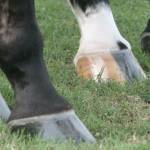Advances in Treating Feet: One Giant Leap for Equines

Injuries occurring to hooves and the structures within them remain the most common cause of lameness in horses.* How these injuries are diagnosed and treated is much different today than it was decades ago. In fact, many cases of foot pain with poor prognosis in the past now have a much better outcome due to advances made in both diagnostics and treatment.
“Historically, horses were given the generic description of ‘foot pain’ and no further attempt or opportunity at identifying the source of that pain was possible. As time marched on and the anatomy of the foot became clearer, differentiating between various causes of foot pain became feasible. With those diagnostic advances came improved treatment options,” shared Laura Petroski-Rose, B.V.M.S, a Kentucky Equine Research veterinarian.
Currently, the most common causes of foot pain in horses include problems in the navicular apparatus, the deep digital flexor tendon as it courses down the back of the foot to attach to the coffin bone, the coffin joint (distal interphalangeal joint), and various other collateral ligaments, joint capsules, and other structures. While comprehensive physical and lameness examinations and diagnostic analgesia—blocking specific regions of the foot with a local anesthetic such as lidocaine—still play important roles in diagnosing foot pain, the equine industry reaps many rewards from magnetic resonance imaging (MRI), computed tomography, and ultrasonography.
“Not only do these tools help diagnose foot pain but also assess a horse’s response to therapy, helping guide a horse’s return to function,” explained Petroski-Rose.
Conservative therapy involving rest, nonsteroidal anti-inflammatory drugs, therapeutic shoeing, and rehabilitation still play a central role in the management of any equine injury. In addition, consider the following medical treatment options available for foot injuries:
-
Directly medicating the coffin joint to make horses with osteoarthritis more comfortable. Medications available for injection include corticosteroids, hyaluronic acid, and polysulfated glycosaminoglycans. A novel polyacrylamide hydrogel can also be used. In some cases, this approach may also help horses with other ailments, as these medications can diffuse to nearby regions, such as the navicular bursa and bone.
-
Biological or regenerative therapies such as stem cells and platelet-rich plasma injected directly into a specific lesion. Typically, this is approached using ultrasound or MRI to guide the injection to the target site. When multiple lesions exist, some veterinarians inject stem cells directly into the arteries or veins supplying the lower limb to provide a more homogenous spread of stem cells to the region.
-
Bisphosphonates for horses diagnosed with degeneration of the navicular bone. These medications reportedly help horses by inhibiting resorption of the navicular bone.
-
Injection of the botulinum toxin (type B). Studies show that injecting this neurotoxin into the navicular bursa of horses with degeneration of the navicular apparatus improved clinical signs. The effect presumably was due to blocking pain fibers.
-
Application of extracorporeal shockwave therapy.
“Even using the most up-to-date therapies may not solve every lameness. Outcome will depend heavily on the use of the horse and the exact nature of the injury, and pros and cons associated with these various treatment options should be discussed fully with your veterinarian,” Petroski-Rose warned.
Laminitis, of course, should never be forgotten when discussing foot pain. Treatment advances have also been made for this common and devastating condition, including stem cell therapy. Don’t throw out the old when bringing in the new, though. Remember, conservative, supportive therapies help horses return to function. This includes nutritional supplements designed to support hoof, foot, and joint health. Look for research-proven joint and hoof products, including KER-Flex, Synovate HA, EO-3, and Bio-Bloom PS.
In Australia, look for Glucos-A-Flex, Synovate HA, EO-3, and Bio-Bloom.
*Gutierrez-Nibeyro, S.D., A.M. McCoy, K.T. Selberg. 2018. Recent advances in conservative and surgical treatment options of common equine foot problems. Veterinary Journal. 237:9-15.








